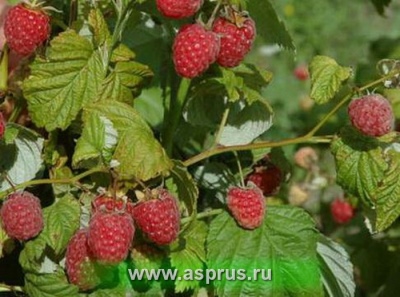
- Authors: Bulgaria
- Repairability: inclined
- Berry color: bright red
- Taste: sweet and sour
- Ripening period: mid-late
- Berry weight, g: 3,5-3,6
- Yield: 9-12 t / ha
- Frost resistance: medium
- Appointment: fresh use, for processing
- Fruiting period: from the end of June
Raspberries of the Bulgarian Rubin variety (synonym for Rubin) appeared in Bulgaria in 1957 when the Kaliningradskaya and Lloyd George varieties were crossed. On the territory of Russia, it became known at the end of the 60s of the XX century. Since then, it has been invariably popular with gardeners due to its high yield and large berries with a delicious taste.
Description of the variety
The Bulgarian Rubin variety is characterized by a powerful and tall, compressed bush with an average number of suckers and replacement shoots, not spreading over the site. This variety reaches a height of about 180 cm. Young shoots are greenish in color and many thick short dark purple thorns with a thickened base of the same color. There is no wax coating on them.
The mature, dull purple shoots are thick and erect and do not bend as the fruit ripens. Their thorns are located exclusively on the lower part of the plant. The variety is characterized by large green leaves, consisting of three small leaves, with slight wrinkling. The Bulgarian Ruby does not need to be planted with other varieties of pollinators.
Ripening terms
Bulgarian Ruby begins to bear fruit from the end of June. In terms of ripening of berries, it belongs to the mid-late varieties. The variety is prone to remontantity with prolonged fruiting. Ripe berries occupy a large area of the branch.
Yield
From the bushes of this variety of raspberries, you can harvest 9-12 t / ha. This means that the Bulgarian Ruby belongs to the high-yielding crops. Fully ripe berries do not crumble. The thorns at the bottom of the stem do not interfere with the harvest.
Berries and their taste
The fruits of the Bulgarian Ruby are bright red and blunt-conical in shape. They are characterized by a large size, the weight of one berry is 3.5-3.6 g. The pulp is dense in consistency. The drupes of the fruit adhere to each other tightly, so the berries do not disintegrate during harvest.
This variety has a sweet and sour taste and a pronounced delicate aroma of wild raspberries. Berries are used for fresh consumption, as well as for processing (preserves, jams). The fruits of the Bulgarian Rubin variety are ideal for freezing. They retain their shape well during transportation.

Growing features
The variety is easy to care for, does not require frequent watering. For about 10 years, it can grow well and bear fruit in one place. But it should be remembered that the Bulgarian Ruby is characterized by moderate frost resistance, and excessive moisture during cultivation can lead to fungal diseases.
Site selection and soil preparation
Raspberries Bulgarian Ruby are recommended to be planted in a sunny, windless area located near a fence or in a corner. The soil should be well-drained, fertile, neutral or slightly acidic. It is prepared two weeks before the autumn planting, and before the spring planting it is fertilized in the autumn, adding sod, compost and manure to the soil. When planting seedlings, the distance between plants in a row should be 30-60 cm, and between rows at least 120 cm.After planting, young bushes must be watered and mulched with peat or humus.



Watering and feeding
The Bulgarian Rubin variety, which is characterized by high drought resistance, requires rare watering 3-4 times per season. It is imperative to water the raspberries during flowering and fruit formation. The variety is fertilized using 20 g of complex fertilizers and 3 kg of manure per 1 m2 of plantings. It should be noted that fertilizing containing nitrogen cannot be applied, since the seedlings will not take root well.



Diseases and pests
Raspberry shoots Bulgarian Ruby are rarely affected by pests, but are less resistant to viruses than more modern varieties. In particular, this variety is not resistant to anthracnose; annual shoots most often suffer from this fungal disease. Gray spots with a red border appear on the leaves and stems, the leaves dry out and die off, the shoots become covered with ulcers, the berries dry out. Infected bushes are treated with fungicides, for example, "Abiga-Peak" or "Quadris". For prevention purposes, plants should be protected from high humidity and acidic soil, potassium and phosphorus should be introduced in a timely manner.
Bulgarian Ruby is also not resistant to didimella (or purple spot). With this disease, lilac spots appear at the base of the plant, which spread upward to the entire stem and to the entire bush, as a result of which the shoots crack, the branches break, and the plant dies. The development of the disease is facilitated by high humidity, planting density, excess nitrogen in the soil. Sick bushes must be burned, and as a preventive measure, treat raspberries Bulgarian Ruby with 1% Bordeaux liquid or Fundazol.

Unfortunately, raspberries, like other plants, do not bypass various diseases and pests. Only by armed with the knowledge and the necessary means for this, you can cope with such troubles.To help the plant, it is very important to be able to recognize the disease in time and begin timely treatment.
Reproduction
Most often, the Bulgarian Rubin variety is propagated by offspring, which are formed on the roots and develop from the adventitious buds. It is better to do this in the fall after the leaves have fallen. It should be noted that the mother bush must be 3-4 years old. In spring, the variety is propagated by green root suckers. For this, shoots with a height of 20-25 cm are dug up with roots and immediately planted.








































































